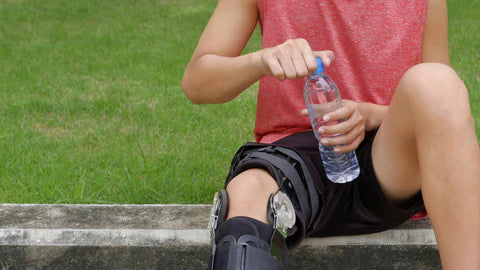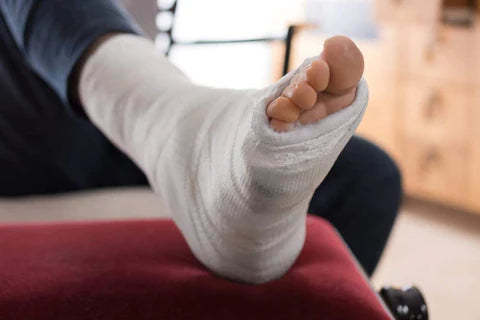
Walking After Non-Weight Bearing: A Guide to Recovery
Disclaimer: This information on this website is only intended to be general summary information for public use. This information does not replace professional medical advice, diagnosis, or treatment. If you have questions about a medical condition, always seek the advice of a doctor or other qualified health professional.

If you've been in a non-weight bearing situation due to an injured leg or foot and ankle issues, the prospect of walking again may feel distant. However, with patience, proper guidance, and the right mindset, you can make a successful transition from non-weight bearing to walking. In this comprehensive guide, we'll cover what you can expect at different stages of recovery and address common questions along the way.
Walking 6 Weeks After Non-Weight Bearing
Reaching the six-week milestone after a non-weight-bearing phase is a critical step in recovery. This period typically marks the beginning of transitioning to partial weight-bearing, which is a gradual process. Sometimes a Non weight bearing Boot can help as you get use to transitioning back.
What to Expect at 6 Weeks:
-
Increased Mobility: You may begin putting slight pressure on your injured leg, often with the aid of crutches, a walker, or a device like the Freedom Leg.
-
Physical Therapy: Your healthcare provider may recommend targeted exercises to rebuild muscle strength and improve range of motion.
-
Pain Monitoring: Expect mild discomfort as your body adjusts to bearing weight again. However, sharp pain should be reported to your doctor immediately.
-
Careful Supervision: Adhere to your healthcare provider’s guidelines for how much weight you can bear. This might be measured as a percentage (e.g., 25% of your body weight).
Tips for Success:
- Use assistive devices as instructed to avoid overloading the healing limb.
- Practice proper posture and gait mechanics during physical therapy sessions.
Walking After 8 Weeks Non-Weight Bearing

By the eighth week, you’re likely making noticeable progress in regaining mobility and strength. This phase involves gradual increases in weight-bearing activities.
What to Expect at 8 Weeks:
-
Improved Strength: Your injured leg should feel stronger as muscles and tissues adapt to the increasing load.
-
Reduced Dependence on Assistive Devices: You might begin to transition from crutches to a cane or the Freedom Leg for more independent mobility.
-
Expanded Exercise Routine: Your rehabilitation program may introduce balance exercises, resistance training, and light stretching.
-
Monitoring Recovery: It's normal to feel tightness or mild soreness, but inflammation or sharp pain should be assessed by your healthcare provider.
Tips for Success:
- Gradually increase weight-bearing as directed, typically 50% of your body weight or more.
- Maintain consistent communication with your physical therapist to track progress and adjust exercises.
Walking After 12 Weeks Non-Weight Bearing
At the 12-week mark, many individuals experience a significant improvement in mobility and strength. Some may even begin walking without assistance, depending on their recovery progress and injury type but a Leg Brace will help.
What to Expect at 12 Weeks:
-
Partial or Full Weight-Bearing: Depending on your specific injury, you may achieve near-normal walking patterns with minimal support.
-
Increased Activity Levels: You can expect to engage in low-impact activities like swimming or stationary cycling to continue rebuilding strength.
-
Potential Challenges: It's important to listen to your body and avoid overexertion, as this phase still carries a risk of setbacks.
Tips for Success:
- Focus on improving walking mechanics, including proper heel-to-toe movement.
- Continue physical therapy for fine-tuning balance and coordination.
- Gradually reintroduce daily activities, like climbing stairs, under your provider’s guidance.
Transition from Non-Weight Bearing to Weight Bearing
Transitioning from non-weight bearing to weight bearing is often one of the most challenging yet rewarding phases of recovery. This process requires patience, persistence, and a carefully structured plan.
What to Expect During the Transition:
-
Step-by-Step Progression: You'll gradually move from no weight to partial and eventually full weight-bearing over weeks or months.
-
Ongoing Physical Therapy: Exercises will target rebuilding strength, stability, and joint function.
-
Monitoring for Complications: Signs of swelling, pain, or instability should be promptly addressed.
-
Supportive Devices: Assistive tools like crutches, walkers, or the Freedom Leg can help you safely transition to walking unassisted.
Tips for a Safe Transition:
- Follow your healthcare provider’s weight-bearing timeline to avoid re-injury. Use this list of Must Haves after Surgery
- Use devices like the Freedom Leg to distribute weight evenly and minimize strain.
- Stay consistent with your rehabilitation program, even when progress feels slow.
Pain After Starting Weight Bearing Recovery

It's common to experience discomfort when you begin weight-bearing activities. This discomfort should be manageable and improve over time. If you encounter severe or persistent pain, consult your healthcare provider to adjust your recovery plan.
Preparing Your Mind and Body for Walking Again
Retraining your brain to walk again is a crucial aspect of recovery. Your mind plays a significant role in regaining mobility, so stay positive and focused on your goals. Adhering to your weight progression timeline will help you regain confidence in your ability to walk.
Frequently Asked Questions (FAQs)
Q: What to do when I accidentally stepped on the non-weight bearing foot?
A: Accidental weight-bearing can happen, but it's essential to avoid it as much as possible. If it occurs, rest and monitor for any adverse effects. If pain or discomfort persists, consult your healthcare provider.
Q: How long does it take to walk again after non-weight bearing?
A: The timeline varies based on your specific situation. It can range from a few weeks to several months. Your healthcare provider will provide a more accurate estimate.
Q: How do I start walking again after foot surgery?
A: Follow your surgeon's post-operative instructions carefully. Physical therapy and a gradual weight progression plan are typically part of the rehabilitation process.
Q: Will I ever walk normally after non-weight bearing?
A: With proper rehabilitation and adherence to your recovery plan, many individuals can regain normal walking abilities.
Q: Can you retrain your brain to walk again?
A: Yes, your brain can adapt and relearn walking patterns. Physical therapy and consistent practice play a crucial role in this process.
Walking again after non-weight bearing is a journey that requires patience, determination, and professional guidance. Always consult your healthcare provider for personalized advice on your recovery path. Remember, with the right mindset and approach, you can regain your mobility and independence.
Regain Your Freedom!

- Regular price
- $449.00
- Sale price
- $449.00
- Regular price
-
$497.00 - Unit price
- per
Dr. Stelmaschuk
"Family Physician, had to have both of his feet repaired and found Freedom Leg very helpful, allowing him freedom to continue particing medicine and even running his snow blower"
Brandon Wise
"Broke his ankle and had to have surgery. The surgeons put screws in his ankle and told him not to put weight on it for 90 days. He was prescibed crutches. Fortunately he discoved Freedom Leg while looking for alternatives on the internet and was able to walk again without difficulty"

